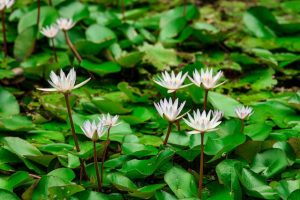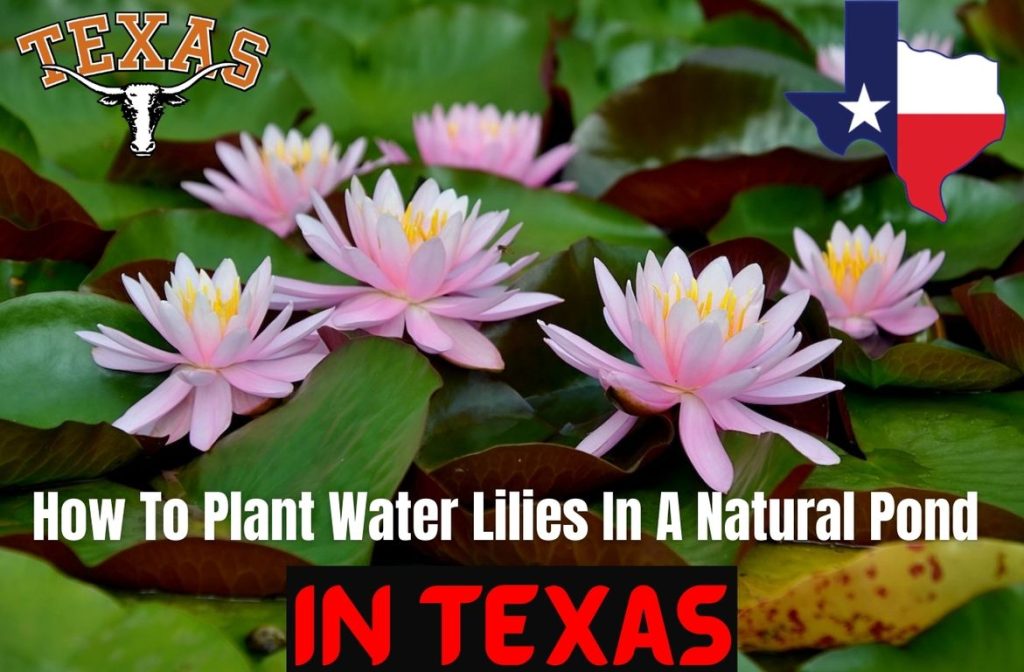You are reading this article that means you live in Texas and thinking of planting water lilies in a natural pond. You are in the right place, because here in this article we will tell you how to plant water lilies in a natural pond in Texas.
Here we will show you a few steps to plant and maintain water lilies in Texas, America. So we hope this article will help you to plant and maintain water lilies properly.
Convenient Way To Plant Water Lilies In Texas Natural Pond

Planting water lilies in a natural pond in Texas can be a beautiful addition to your landscape. Here’s a step-by-step guide on how to do it:
1. Choose The Right Water Lily Species:
Select water lily species that are well-suited to the Texas climate. Native species like the Texas Dawn and Texas Shell Pink are good choices.
2. Select A Suitable Location:
Pick a spot in your pond with adequate sunlight. Water lilies typically require at least 6 hours of direct sunlight each day.
3. Prepare The Pond:
Ensure your pond is properly constructed and has a stable ecosystem. Remove any invasive plants and algae that may compete with the water lilies. If there is any algae then remove them fast, you can simply use vinegar.
By the way, how fast does vinegar kill algae in ponds, we described it in our previous article, you can check this article.
4. Prepare The Containers:
Water lilies are usually planted in containers or pots. Use plastic or fabric pots with no holes to prevent soil from leaking into the pond.
5. Potting Mix:
Use a heavy clay loam or a specialized aquatic plant potting mix. Avoid using garden soil or topsoil, as they can cloud the water.
6. Plant The Water Lilies:
Place the potted water lily in the pond at the desired depth. Water lilies should be planted about 18 inches to 24 inches deep in the water. Ensure the growing tip (crown) is above the soil surface.
7. Fertilize:
Use aquatic fertilizer tablets to promote healthy growth. Push the tablets into the soil near the roots of the water lily.
8. Cover With Gravel Or Stones:
To prevent fish from disturbing the plant and to anchor it, cover the surface of the pot with a layer of gravel or stones.
9. Submerge Gradually:
Slowly lower the potted water lily into the pond to avoid disturbing the soil. Gradually submerge it to the recommended depth.
10. Maintain Water Quality:
Monitor water quality regularly. Ensure the pond has proper filtration and circulation to maintain clear water and prevent algae overgrowth.
11. Pruning And Maintenance:
Trim dead or yellowing leaves and flowers regularly to encourage new growth and flowering.
12. Winter Care:
In Texas, water lilies may remain active year-round. However, if you experience freezing temperatures, move potted water lilies to deeper, unfrozen areas of the pond to protect them from frost damage.
13. Monitor Growth:
Keep an eye on the water lilies’ growth, and if they outgrow their containers, divide and repot them as needed.
14. Enjoy Your Water Lilies:
Sit back and enjoy the beauty of your water lilies as they bloom and enhance the natural beauty of your Texas pond.
Remember that the specific care requirements may vary depending on the water lily species and the local conditions in your Texas pond. Regular maintenance and care will help your water lilies thrive and add natural beauty to your pond environment.
Frequently Asked Questions
Q: When is the best time to plant water lilies in a Texas pond?
A: The best time to plant water lilies in a Texas pond is during spring, typically in late March or April when the threat of frost has passed and water temperatures reach 70-75°F (21-24°C). This ensures optimal conditions for growth, with abundant sunlight and proper water depth for healthy water lilies.
Q: What types of water lilies are native or well-suited for Texas ponds?
A: Several native and well-suited water lilies for Texas ponds include the Texas water lily (Nymphaea elegans), the American white water lily (Nymphaea odorata), and the southern or yellow water lily (Nuphar lutea).
Hardy and tropical water lily varieties, like the ‘Texas Dawn’ or ‘N. ‘Blue Beauty,’ is also a popular choice for Texas ponds.
Q: How deep should I plant water lilies in my Texas pond?
A: In a Texas pond, plant water lilies at a depth of 12 to 18 inches for hardy varieties and 6 to 12 inches for tropical types. This depth allows them to access sufficient sunlight while maintaining stability in the water, promoting healthy growth and vibrant blooms.
Q: What kind of soil or substrate is ideal for water lilies in a Texas pond?
A: For water lilies in a Texas pond, use a mix of heavy clay soil and aquatic plant fertilizer. This combination provides essential nutrients and stability for healthy growth.
Q: Do water lilies require a lot of sunlight, and how can I ensure they get enough in a Texas climate?
A: Yes, water lilies require ample sunlight for healthy growth and blooming. In a Texas climate, ensure they receive at least 6 hours of direct sunlight daily. Select a pond location with full sun exposure, avoiding shade from trees or structures.
Regularly trim or thin out any overhanging branches or debris that may block sunlight. Adequate sunlight is essential for vibrant water lily growth and the development of their characteristic stunning flowers.
Q: What are the steps for planting water lilies to ensure they thrive in a Texas pond?
A: To ensure thriving water lilies in a Texas pond, follow these steps:
Timing: Plant in late March or April when frost risk is low and water temperature reaches 70-75°F.
Soil: Use a mix of heavy clay soil and aquatic plant fertilizer.
Depth: Plant hardy varieties 12-18 inches deep, tropical ones 6-12 inches deep.
Sunlight: Ensure at least 6 hours of daily direct sunlight.
Maintenance: Regularly remove dead leaves and flowers, and divide plants every 2-3 years.
Q: Are there any specific care and maintenance tips for Texas water lilies throughout the year?
A: For Texas water lilies, maintain a consistent water temperature, protect from freezing in winter, provide ample sunlight, and perform regular maintenance by removing dead foliage and dividing overcrowded plants every few years.
Q: How do I prevent or manage pests and diseases that can affect water lilies in Texas?
A: Prevent pests and diseases in Texas water lilies by ensuring good pond hygiene, promoting strong plant growth with appropriate nutrients, and promptly removing any affected leaves or plants.
Regularly inspect for signs of aphids, snails, and fungal infections, and consider using non-toxic biological controls if necessary to manage infestations.
Q: Can I grow water lilies in a container or pot within my Texas pond?
A: Yes, you can grow water lilies in containers or pots within your Texas pond. This allows better control of their growth and prevents them from spreading too aggressively.
Q: What are the benefits of planting water lilies in a Texas pond for the local ecosystem?
A: Planting water lilies in a Texas pond offers several benefits for the local ecosystem. They provide shade, reducing water temperature and preventing algae growth. Their floating leaves offer habitat and protection for fish and aquatic organisms.
Water lilies also enhance water quality by absorbing excess nutrients and releasing oxygen, benefiting aquatic life. Moreover, their attractive blooms attract pollinators like bees and butterflies, contributing to overall biodiversity in the area.
Q: Do I need to fertilize water lilies in my Texas pond, and if so, how often and with what type of fertilizer?
A: Yes, fertilizing water lilies in a Texas pond is important for their growth. Use a specialized aquatic plant fertilizer designed for water lilies.
Apply it monthly during the growing season (spring to early fall) following package instructions. This ensures they receive essential nutrients for healthy development and vibrant blooms.
Q: Are there any legal considerations or permits required for planting water lilies in a Texas pond, especially if it’s a natural or protected area?
A: In Texas, there might be legal considerations and permits required for planting water lilies in a pond, especially in natural or protected areas. Regulations can vary based on local, state, or federal authorities.
It’s advisable to consult with your local wildlife agency or environmental department to determine if any permits or approvals are necessary before undertaking any planting activities in such areas. Complying with regulations helps protect the ecosystem and avoids potential legal issues.
Q: What should I do if the water lilies in my Texas pond appear to be struggling or not blooming as expected?
A: If your Texas pond water lilies are struggling or not blooming well, check water quality, ensure they receive enough sunlight, and fertilize as needed. Remove dead leaves, consider dividing overcrowded plants, and monitor for pests or diseases. Adjust care and maintenance accordingly for improved health and blooming.
Q: Can I introduce fish to my Texas pond with water lilies, and will they affect the plants?
A: Yes, you can introduce fish to your Texas pond with water lilies. However, some fish species may nibble on water lily leaves, potentially damaging them. Consider fish compatibility and monitor plant health accordingly.
Final Words
Today we have shown 14 steps on how you can plant water lilies in a natural pond in Texas. These steps also cover the maintenance of water lilies. Here we also covered some frequently asked questions about Texas and water lilies like the maintenance, proper planting time, benefits, fertilizer, and others. Hope you enjoyed this article.





